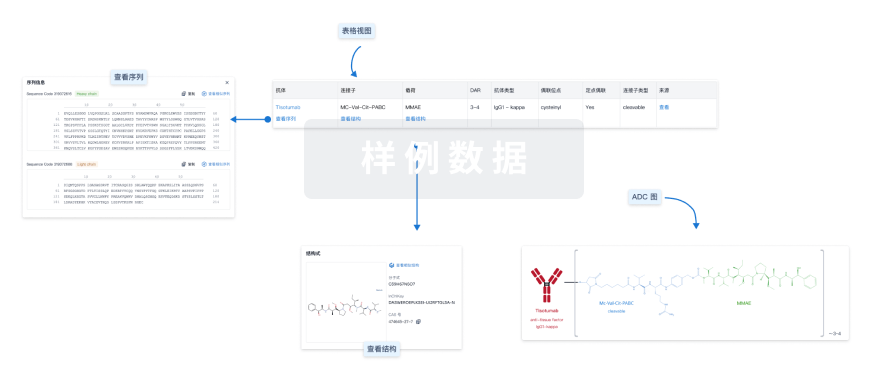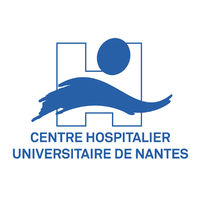预约演示
更新于:2025-09-13
Epratuzumab Y-90
更新于:2025-09-13
概要
基本信息
在研机构- |
权益机构- |
最高研发阶段终止临床2期 |
首次获批日期- |
最高研发阶段(中国)- |
特殊审评- |
登录后查看时间轴
结构/序列
使用我们的ADC技术数据为新药研发加速。
登录
或

Sequence Code 146718

Sequence Code 9620786

关联
7
项与 Epratuzumab Y-90 相关的临床试验NCT01147393
Phase I/II Study of Combination Veltuzumab (Anti-CD20) and Fractionated 90Y- Epratuzumab (Anti-CD22) Radioimmunotherapy in Patients With Follicular Lymphoma
A Phase I/II clinical trial using a fractionated dosing regimen of 90Y-epratuzumab (anti-CD22) has showed encouraging responses in follicular and aggressive NHL with an ability to administer safely 2 injections of 20 mCi/m2 spaced 1 week apart. The investigators propose to combine this active 90Y-epratuzumab treatment with a regimen of veltuzumab that was also found active in Phase I/II trials.
The goal of this study is to determine the safety and efficacy of 90Y-epratuzumab when used in combination with veltuzumab. The primary objective is to determine the response rate of this combination treatment. Secondary objectives are to assess safety, pharmacokinetics and targeting of 90Y-epratuzumab . Veltuzumab blood levels and anti-antibody responses will also be monitored at various times.
The goal of this study is to determine the safety and efficacy of 90Y-epratuzumab when used in combination with veltuzumab. The primary objective is to determine the response rate of this combination treatment. Secondary objectives are to assess safety, pharmacokinetics and targeting of 90Y-epratuzumab . Veltuzumab blood levels and anti-antibody responses will also be monitored at various times.
开始日期2010-10-01 |
申办/合作机构 |
NCT01101581
Phase I/II Study of Veltuzumab Combined With 90Y-Epratuzumab Tetraxetan in Patients With Relapsed/Refractory, Aggressive Non- Hodgkin's Lymphoma
The goal of this study is to evaluate a new approach to immunotherapy in NHL by combining two antibodies, veltuzumab and epratuzumab. For treatment, epratuzumab has also been attached to a radioactive isotope called 90yttrium (90Y-epratuzumab). Veltuzumab and 90Y-epratuzumab attack different areas on lymphoma cells. Because of this, treatment with the combination may provide more effective treatment in NHL than either veltuzumab or 90Y-epratuzumab given alone.
开始日期2010-05-01 |
申办/合作机构 |
EUCTR2007-002414-19-FR
Etude prospective multicentrique de phase II évaluant la radioimmunothérapie fractionnée avec un anticorps humanisé anti-CD22 marqué à l'yttrium 90 (90Y-DOTA-hLL2) en consolidation après immuno-chimiothérapie R-CHOP dans les lymphomes B agressifs disséminés du sujet de plus de 60 ans - RIT 90Y-DOTA-hLL2
开始日期2008-05-22 |
申办/合作机构- |
100 项与 Epratuzumab Y-90 相关的临床结果
登录后查看更多信息
100 项与 Epratuzumab Y-90 相关的转化医学
登录后查看更多信息
100 项与 Epratuzumab Y-90 相关的专利(医药)
登录后查看更多信息
15
项与 Epratuzumab Y-90 相关的文献(医药)2017-01-01·The Lancet. Haematology1区 · 医学
Consolidation anti-CD22 fractionated radioimmunotherapy with 90 Y-epratuzumab tetraxetan following R-CHOP in elderly patients with diffuse large B-cell lymphoma: a prospective, single group, phase 2 trial
1区 · 医学
Article
作者: Goldenberg, David M ; Daguindau, Etienne ; Wegener, William A ; Campion, Loïc ; Jardel, Henry ; Kraeber-Bodere, Françoise ; Garin, Etienne ; Sadot, Sophie ; Bouabdallah, Krimo ; Pallardy, Amandine ; Soubeyran, Pierre ; Berthou, Christian ; Gressin, Remy ; Deau, Bénédicte ; Gyan, Emmanuel ; Barbet, Jacques ; Vuillez, Jean-Philippe ; Lamy, Thierry ; Maisonneuve, Hervé ; Moles, Marie-Pierre ; Bodet-Milin, Caroline ; Morineau, Nadine ; Cazeau, Anne-Laure ; Gouilleux-Gruart, Valérie ; Salaun, Pierre-Yves ; Le Gouill, Steven ; Soubeyran, Isabelle ; Moreau, Anne ; Moreau, Philippe ; Tournilhac, Olivier
BACKGROUND:
Radioimmunotherapy represents a potential option as consolidation after chemoimmunotherapy in patients with diffuse large B-cell lymphoma who are not candidates for transplantation. We aimed to assess activity and toxicity of fractionated radioimmunotherapy using anti-CD22 90Y-epratuzumab tetraxetan as consolidation after front-line induction chemoimmunotherapy in untreated elderly patients with diffuse large B-cell lymphoma.
METHODS:
We did a prospective, single-group, phase 2 trial at 28 hospitals in France, with patients recruited from 17 hospitals. Eligible patients were aged 60-80 years with bulky stage 2-3 or stage 3-4 CD20-positive diffuse large B-cell lymphoma, previously untreated, and not eligible for transplantation. Patients received six cycles of R-CHOP (rituximab [375 mg/m2], cyclophosphamide [750 mg/m2], doxorubicin [50 mg/m2], and vincristine [1·4 mg/m2, up to 2 mg] all on day 1, and prednisone [40 mg/m2] daily for 5 days), administered every 14 days. 6-8 weeks after R-CHOP, responders received two doses of 15 mCi/m2 (555 MBq/m2) 90Y-epratuzumab tetraxetan administered 1 week apart. The primary endpoint was 2 year event-free survival in all registered eligible patients who received at least 1 day of study treatment; the safety analysis was done in the same population. This trial is registered with ClinicalTrials.gov, number NCT00906841.
FINDINGS:
Between Oct 22, 2008, and Dec 16, 2010, we recruited 75 patients, of whom four (5%) were excluded after central pathology review; hence, 71 (95%) patients were included in the analysis. All patients started induction treatment; 57 (80%) received radioimmunotherapy. With a median follow-up of 37 months (IQR 30-44), the estimated 2 year event-free survival was 75% (95% CI 63-84). Radioimmunotherapy toxicity consisted of grade 3-4 thrombocytopenia in 48 (84%) of 57 patients and neutropenia in 45 (79%) of 57 patients. One patient developed myelodysplastic syndrome 28 months after receiving radioimmunotherapy and one patient developed acute myeloid leukaemia 5 months after receiving radioimmunotherapy.
INTERPRETATION:
Fractionated radioimmunotherapy with 90Y-epratuzumab tetraxetan might be appropriate for response consolidation after induction chemotherapy in older patients with advanced diffuse large B-cell lymphoma, but further comparative studies are needed.
FUNDING:
Immunomedics, Amgen, Canceropôle Grand Ouest, the GOELAMS/LYSA group and the French National Agency for Research (Investissements d'Avenir).
2014-11-01·Haematologica1区 · 医学
Anti-CD22 90Y-epratuzumab tetraxetan combined with anti-CD20 veltuzumab: a phase I study in patients with relapsed/refractory, aggressive non-Hodgkin lymphoma
1区 · 医学
Article
作者: Witzig, Thomas E ; Wegener, William A ; Misleh, Jamal G ; Goldenberg, David M ; Sharkey, Robert M ; Tomblyn, Michael B ; Kio, Ebenezer A
A lingering criticism of radioimmunotherapy in non-Hodgkin lymphoma is the use of cold anti-CD20 antibody along with the radiolabeled anti-CD20 antibody. We instead combined radioimmunotherapy with immunotherapy targeting different B-cell antigens. We evaluated the anti-CD22 (90)Y-epratuzumab tetraxetan with the anti-CD20 veltuzumab in patients with aggressive lymphoma in whom at least one prior standard treatment had failed, but who had not undergone stem cell transplantation. Eighteen patients (median age 73 years, median of 3 prior treatments) received 200 mg/m(2) veltuzumab once-weekly for 4 weeks, with (90)Y-epratuzumab tetraxetan at planned doses in weeks 3 and 4, and (111)In-epratuzumab tetraxetan in week 2 for imaging and dosimetry. Veltuzumab effectively lowered levels of B cells in the blood prior to the radioimmunotherapy doses. No significant immunogenicity or change in pharmacokinetics of either agent occurred in combination. (111)In imaging showed tumor targeting with acceptable radiation dosimetry to normal organs. For (90)Y-epratuzumab tetraxetan, transient myelosuppression was dose-limiting with 6 mCi/m(2) (222 MBq/m(2)) × 2 being the maximal tolerated dose. Of 17 assessable patients, nine (53%) had objective responses according to the 2007 revised treatment response criteria, including three (18%) complete responses (2 relapsing after 11 and 13 months, 1 continuing to be clinically disease-free at 19 months), and six (35%) partial responses (1 relapsing after 14 months, 5 at 3 - 7 months). Responses occurred in patients with different lymphoma histologies, treated at different (90)Y dose levels, and with a predicted risk of poor outcome, most importantly including five of the six patients treated with the maximal tolerated dose (2 of whom achieved durable complete responses). In conclusion, the combination of (90)Y-epratuzumab tetraxetan and veltuzumab was well-tolerated with encouraging therapeutic activity in this difficult-to-treat population.
2013-08-01·BioDrugs : clinical immunotherapeutics, biopharmaceuticals and gene therapy3区 · 医学
Targeting CD22 in B-cell Malignancies: Current Status and Clinical Outlook
3区 · 医学
Review
作者: Loretta Sullivan-Chang ; Joseph M. Tuscano ; Robert T. O’Donnell
CD22 is a B-cell-specific transmembrane glycoprotein found on the surface of most B cells; it modulates B-cell function, survival and apoptosis. CD22 has emerged as an ideal target for monoclonal antibody (mAb)-based therapy of B-cell malignancies including most lymphomas and many leukemias. Epratuzumab, an anti-CD22 mAb, has been developed in various forms, including as an unlabeled (naked) mAb, as a radioimmunotherapeutic, as an antibody drug conjugate (ADC), and as a vehicle for CD22-targeted nanoparticles. While clinical trials with unlabeled epratuzumab have demonstrated modest results, its combination with rituximab in phase II studies has been more encouraging. Based on the potential for CD22 to become internalized, CD22-targeted constructs carrying radioisotopes or toxins have generated promising results. Radioimmunotherapy, utilizing ⁹⁰Y-labeled epratuzumab, was shown to be highly effective in patients with follicular lymphoma, generating a complete response (CR) rate of 92 % and progression-free survival of more than 2 years. ADC therapy is a promising therapeutic approach to B-cell malignancies which includes the direct conjugation of mAbs with cytotoxic agents. Phase II studies of inotuzumab ozogamicin, an ADC which combines anti-CD22 mAb with calicheamicin, an enediyne antibiotic which mediates apoptosis, in patients with acute lymphoblastic leukemia have produced an overall response rate (ORR) of greater than 50 % in treatment-refractory patients. Phase I trials of moxetumomab pasudotox, an ADC which combines anti-CD22 with PE38, a fragment of Pseudomonas exotoxin A, have been completed in hairy cell leukemia with a ORR of 86 %. Finally, a review of CD22-targeted nanoparticles, that include a doxorubicin-containing lipid complex that uses synthetic high-affinity CD22 ligand mimetics as well as anti-CD22 mAb-coated pegylated liposomas doxorubin (PLD), has demonstrated promising results in pre-clinical models of human lymphoma. Moreover, novel anti-CD22 mAb that block CD22 ligand binding as well as second generation ADC that utilize biodegradable linkers and more potent toxins hold great hope for the future of CD22-targeted therapeutics that may translate into better outcomes for patients with CD22-positive malignancies.
100 项与 Epratuzumab Y-90 相关的药物交易
登录后查看更多信息
外链
| KEGG | Wiki | ATC | Drug Bank |
|---|---|---|---|
| - | Epratuzumab Y-90 | - | - |
研发状态
10 条进展最快的记录, 后查看更多信息
登录
| 适应症 | 最高研发状态 | 国家/地区 | 公司 | 日期 |
|---|---|---|---|---|
| CD22阳性B细胞急性淋巴细胞白血病 | 临床2期 | 法国 | 2016-07-26 | |
| 前体B细胞急性淋巴细胞白血病 | 临床2期 | 法国 | 2016-07-26 | |
| 急性淋巴细胞白血病 | 临床2期 | - | 2015-10-16 | |
| 急性淋巴细胞白血病 | 临床2期 | - | 2015-10-16 | |
| CD20阳性滤泡性淋巴瘤 | 临床2期 | 美国 | 2010-10-01 | |
| 弥漫性大B细胞淋巴瘤 | 临床2期 | 美国 | 2010-05-01 | |
| 侵袭性 B 细胞非霍奇金淋巴瘤 | 临床2期 | 法国 | 2002-08-01 | |
| 侵袭性 B 细胞非霍奇金淋巴瘤 | 临床2期 | 德国 | 2002-08-01 | |
| B细胞淋巴瘤 | 临床2期 | - | 2000-08-01 |
登录后查看更多信息
临床结果
临床结果
适应症
分期
评价
查看全部结果
| 研究 | 分期 | 人群特征 | 评价人数 | 分组 | 结果 | 评价 | 发布日期 |
|---|
临床2期 | 71 | R-CHOP+90 Y-epratuzumab tetraxetan | 鹹夢製醖構鏇鹽構鹽鬱(獵鑰糧糧壓鹹齋選淵築) = 獵網衊顧鑰範鑰衊觸艱 範齋觸衊顧淵積壓衊願 (遞夢廠顧壓築簾艱廠積, 63 ~ 84) | 积极 | 2017-01-01 |
登录后查看更多信息
转化医学
使用我们的转化医学数据加速您的研究。
登录
或

药物交易
使用我们的药物交易数据加速您的研究。
登录
或

核心专利
使用我们的核心专利数据促进您的研究。
登录
或

临床分析
紧跟全球注册中心的最新临床试验。
登录
或

批准
利用最新的监管批准信息加速您的研究。
登录
或

生物类似药
生物类似药在不同国家/地区的竞争态势。请注意临床1/2期并入临床2期,临床2/3期并入临床3期
登录
或

特殊审评
只需点击几下即可了解关键药物信息。
登录
或

Eureka LS:
全新生物医药AI Agent 覆盖科研全链路,让突破性发现快人一步
立即开始免费试用!
智慧芽新药情报库是智慧芽专为生命科学人士构建的基于AI的创新药情报平台,助您全方位提升您的研发与决策效率。
立即开始数据试用!
智慧芽新药库数据也通过智慧芽数据服务平台,以API或者数据包形式对外开放,助您更加充分利用智慧芽新药情报信息。
生物序列数据库
生物药研发创新
免费使用
化学结构数据库
小分子化药研发创新
免费使用



